Creating Double Spiral of Success by Converting Dys- after Dys- into Human Sociality and Economic Potentiality using an Ethics of Care & Answerability
By David M. Boje, updated Dec 3 2013; Revised Jan 11 2014
First, instead of doing three projects in a row, stop walking straight lines. Don't do it this way: ![]() For example, in consulting to KMC EMPOWERING EDUCATIONAL CORPORATION, INC. (KMC-EEC, INC.), I advised the Grant Writing Committee to develop the first Grant Application, then do two more projects.
For example, in consulting to KMC EMPOWERING EDUCATIONAL CORPORATION, INC. (KMC-EEC, INC.), I advised the Grant Writing Committee to develop the first Grant Application, then do two more projects.
Second, instead of repeating the same project three times, and making a cycle of sameness, construct three projects that build one upon the other. Instead of KMC-EEC, INC. just writing three grants, the strategy is to build one upon the other.
Don't do it this way either:

Figure 1: This is the Wrong and Silly way to do three projects for a client during a semester
Why not jsut do three grants at KMC-EEC, INC.? Because you wind up where you started. Three grants with no synergy. Because the projects are sequential, you don't build on each other. No synchronicity is possible. Because you did not build momentum, you are not multiplying the efforts of the Grants Committee at KMC-EEC, INC.
Third, do three D-P-I-Es. D stands for Diagnosis, P for Project, I for Implementation, and E for Evaluation. With each Grant, do a D-P-I-E.
The D-P-I-E cycle Savall, Zardet, and Bonnet (2008: 21-24) is fundamental to releasing the untapped potentional of enterprises thorugh socioeconomic intervention in Dys-, Dys-, Dys-. In your interventions do at least three D-P-I-E cycles, each new one built on the last one, to build momentum and a powerful force of transformation
Daignosis- every Dys- its excess and deficiency. Include direct quotes of particpants, cost out what it is doing to revenues and costs of the entire organization (chart it in a table). Make three recommendations of how to change it, how to convert the Dys- to potential.
Project- Cooperative plan a project with your client. Does you no good to plan it then sell it to them. Participation is the first principle of democracric governance. The human potential and economic potential are unleashed by the acts of your co-participation, in learning democratic socioeconomics. That means share the rewards of innovations with the people who innovate.
Implementation- It is again collaborative. You do not do it for them. You work with them to implement.
Evaluation- You need all kinds of indicators, qualitative and quantitative of the old and new performance.
Repeat D-P-I-E at least three times.
Here is the really important part of it:
Each project is part of D-P-I-E, and the D-P-I-Es build upon each other. How? By tweaking the second and third project to build upon what you learn, notice, and evaluate in the first project. And by tweking the third project by learning, noticing, and evaluating projects 1 and 2. In our KMC-EEC, INC. example, the three grants are the projects to be written, submitted, over a year's time.
The result of doing the D-P-I-Es is you transfrom a cycle into a spiral. Instead of playing small (write 3 grants), play big, and build one upon the other.
In the socioeconomic approach its all a matter of slowly converting the dysfunctions (excess and deficiency, in Aristotle Virtue Ethics) to what Mikhail Bahhtin (1991, 1993) calls the 'ethics of answerability' to intervene in the sociality and in the economics of utilitarian greed, in order to establish a new ethics, answerability. This is done in Savall, Zardet and Bonnet (2008) by paying attention to Diagnosis of DYS (dysfunciton), DYS after DYS is converted, flushed out of the organization processes, its resource drains converted to investment in upsurge.
Question: What are your Three D-P-I-Es to build an Upsurge Spiral?
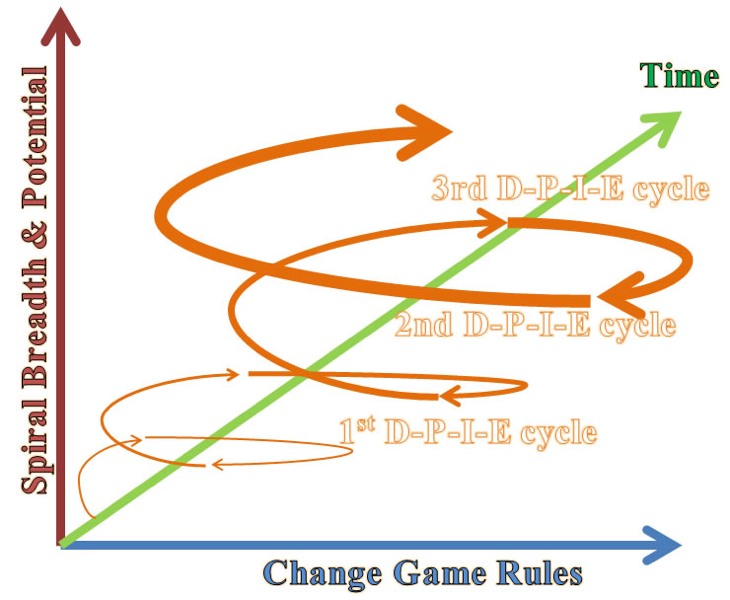
Figure 2- How to Stacke three D-P-I-Es cycles, while turning them into an Upsurge Spiral by converting Dys-, Dys-, Dys- into resources (Source, Boje, forthcoming).
Next Step: Instead of just one Spiral that is upwards, make it a Double Spiral of Success.
Here is the Secret: Convert all those Dys-after-Dys-after-Dys found in each Diagnosis into Resources to pay for all the Projects. Transmute: Transform the Dysfunctions (Dys-after-Dys) into Resources your client invest in Projects. How? Create a downward Spiral of Dys that get flushed out of the Organization's processes, structures, behavior habits, strategies, etc. Now take those savings in money, time, personnel, and reinvest into the Projects that build the Success of the Small Business!
Here is how to draw a spiral
First use Word symbol shape (wavy line) to make this figure. Duplicate the figure and stack them to make a spiral that you can add text boxes into.

Then put in Text Boxes, symbols and arrows so that the Datable Moments are put in for each D-P-I-E loop. For example, Boje is working on this implementation of an NMSU Sustainability Minor.

NMSU earned its Gold Star rating in Sustainability, NOv 30 2012. ADAC stands for Associate Deans Academic Council. They make decisions onf minors and majors at NMSU. The negotiations are in their 2nd ADAC meeting where the topic on 13 Jan 2014 is getting approval for developing STARS audit, putting Green leaf on first 50 courses (most already vetted through the Antrhpology Department's minor in sustainability), and introduction of several University Sustainability Minor Steering Committee Members. OIA in the figure stands for Office of Institutional Analysis (a work order has been submitted and discussions of it start 13 Jan 2014. Since then a Diagnosis by Sustainability Council and sustainability leaders across campus focused on building a three track miror. Plans for the Univeristy-wide Sustinability Minor have been drafted. The President's Excellence Fund for expanding enrollment awarded the plan $15K, of which $5K is for marketing. see Http://peaceaware.com/sustainability for the History and description of the Project. Lots of good storytelling was done in interviews over past four years to get this off the ground. There are 8 datable events taking place in the plan for the 1st D-P-I-E loop. At the end of D-P-I-E Loop #1 there is an evaluation of all activities in that loop in order to learn and grow into the next loop of the spiral.
The purpose of D-P-I-E loop #2 is to build momentum from the 1st loop, learn, and grow the spiral so it draws in more participants, more funding, more visibility withing the university, and becomes an identity marker for the entire university resulting in employers seeking out graduates with a Sustainability Minor from NMSU.
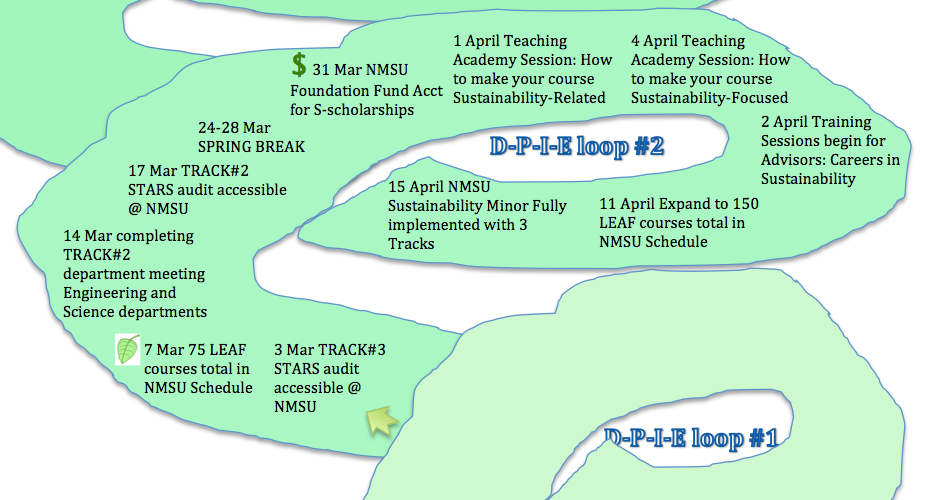
Next look at four DPIE loops for the Sustainability Minor @ NMSU.
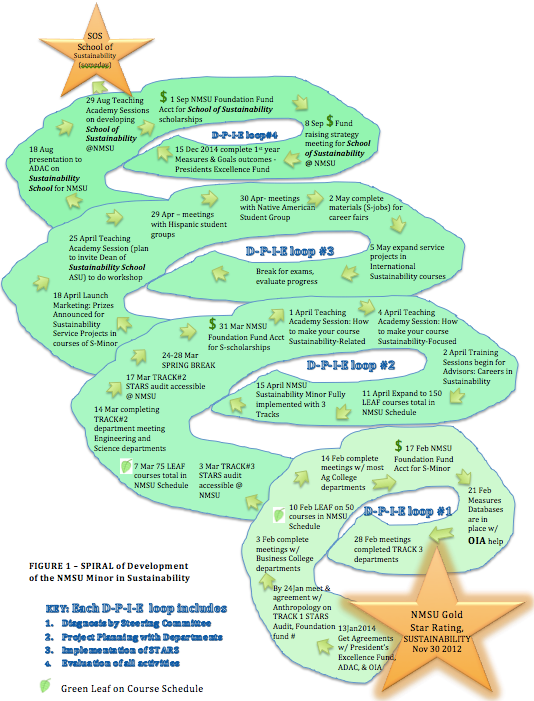
NEXT how to convert DYS (dysfunction to Resources by developing a DOUBLE Spiral: Draw a double spiral, a downward spiral flushing out dysfunction after dysfuntion in order to turn those socioeconomic resources into potentialities for developing projects to increase human and economic potential for the organization. Here is an example drawn by a Mgt 448 student, Ruby Galendo, that I modified a bit. For this next semester, please use the format suggested above with wider paths in several specified D-P-I-E loops where you list the specific datable moments of your implementations. The point of this next drawing is to show you the history that happened before 2014. Notice the Gold Star labeled 2013 Gold Star Earned (actually we got there ahead of projections, in Nov 2012). We went from pronce in early 2012 to Gold in late 2012, and skipped Silver altogether.
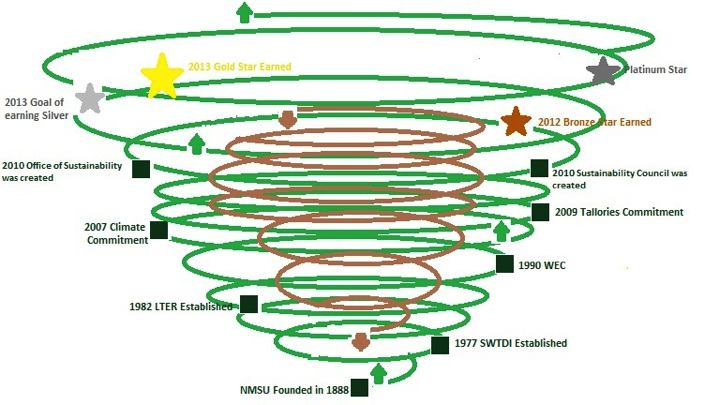
Figure 3 – What a Double Spiral of Dys- Intervention to Build Upsurge of Socioeconomic Potentiation Looks Like (Boje, 2014, forthcoming)
In the above Double Spiral, New Mexico State University began flushing out dysfunctions of non-sustainability in its operations, curriculum, and student, staff, and faculty carbon footprint, etc. For examples of moving from Dys-after-Dys to Double Spiral of Success see http://peaceaware.com/sustainability/history.htm
Several of your student projects in the small business consulting class (Mgt 448/548) and the graduate seminar in systems theory (Mgt 655) helped the Double Spiral happen.
Slowly this created slack resources to reinvest and by doing D-P-I-Es that built one on the next, a huge momentum for an Upsurge Spiral, an Upward Spiral of Success got implemented.
NMSU edid this moving from failing grades in sustainability until it got its Bronze Star, and then spipped over Silver to get its Gold Star. No university in America has a Platnum Star. Let's be the first!
POINT OUT Where The DYS after DYS Diagnosis IS in your report and where you converted lost human, and economic potential to potentiality for the future, a bet on the future, an 'antenarrative' as Boje (2001, 2008, 2011, 2014 forthcoming) calls it.

Figure 4 – What a Double Spiral of Disjointure Looks Like
Where the upward and the downward spiral meet, is a point of disjointure, where Dys- after Dys- must get converted, transformed into potentiality. This is done by careful diagnosis, bringing your fieldnotes and caluculations to the attention of management and everyone in the organizaiton. It is the basis for paying for projects of intervention to change the Dys- into human potential and revenue potential.
A secret: its a matter of bringing democratic participation and an ethics of answerability to intervene in every Dys-, Dys-, Dys- converning them to resources to invest in projects.
How does the Double Spiral Move in the Small Business Environment
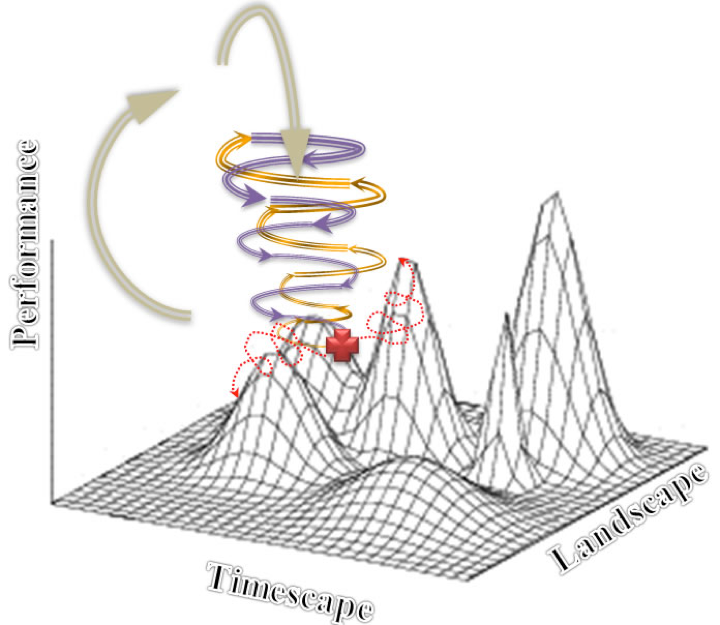
Figure 5 – Double Spiral’s possible moves across an environment of Landscape, Timescape and Performance
As you implment the Double Spiral, flushing out Dys- after Dys- in the downward spiral, converting resources to potential in D-P-I-E cycles that stack into an Upsurge Spiral of Success, the organization can move more effectively in its environment, compete better, with an ethics of answerability and some great virtue ethics of social and economic justice.
In the above figure the Double Spiral of the organization moved in those little dotted line pathways, in its environment, finding worse and sometimes better spaces in the landscape, in timescape, and in performance. The landscape is the spaces of locating resources, competing for them, cooperating to attain them. The timescape is just clock time (punching the clock) at the lowest level of understanding. At the highest it is Kairos, learning timing strategy, and learning Diagnosis that is in the moment, a mindful of democratic soceioeconomic strategy day to day. Performance is all those things you have been doing to improve it in the Evaluation after Evaluation in the D-P-I-Es. Do it right with moral integrity and in the long and short run of the timescape you become a winner!
Click here for a PDF you can print outto review the Implementation Plans for 2014.
Boje (forthcoming).

Available from Routledge in 2014
For more on history of sustainbility at NMSU see http://peaceaware.com/sustainability/history.htm
Aguirre, G; Boje, D.;Cast, M.;Conner, S. Helmuth, C.; Mittal, R.; Saylors, R.; Tourani, N.; Vendette, S.; Yan, T. Q. (2013). “University Sustainability and System Ontology,” Special Issue: Organizational Innovations and Responses for Universal Equilibrium, International Journal of Organization Theory and Behavior, Vol. 15(4): 577-618.Accepted October 2012. The journal has a 90% rejection rate, so receiving a first round accept, was good news. Co-authors are from Management and Marketing departments of New Mexico State University, and are listed in alphabetical order. Click here for pre press pdf.